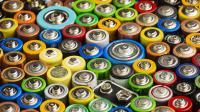M-ERA.NET Call 2023 – three projects with WUT scientists
Our researchers will participate in three international projects on materials science and engineering. Funding will be provided by the National Science Centre.
Consortia of at least three research teams from 29 countries were eligible to apply for the M-ERA.NET Call 2023. It is organised by the M-ERA.NET 3 network, which the National Science Centre is a part of. The subject matter of the competition included the fields of materials science and engineering.
ULTRADRY
Scientists from the Warsaw University of Technology are the leaders of Polish teams in two projects. The first is ULTRADRY, or "Unleashing the potential of sustainable and solvent-free electrode production for lithium-ion cells".
– The aim of the project is to modernise the production of cells in accordance with the principles of sustainable development – says Prof. Marek Marcinek from the Faculty of Chemistry, who will lead the research.
As part of the work, electrodes for lithium-ion batteries (LIBs) will be prepared "dry", i.e. without the use of solvents, which will also reduce the overall energy consumption during production. The content of harmful substances in the binder and electrolyte will also be reduced.
– The project will contribute to making European cell production less expensive, more sustainable and energy-efficient – emphasises Prof. Marek Marcinek.
SusHiBatt
– The development of reliable, safe, and at the same time efficient and cost-effective batteries is a key element of sustainable mobility and energy supply – says Prof. Leszek Niedzicki from the Faculty of Chemistry. – However, increased battery use requires resource-saving and efficiency-enhancing measures – he adds.
Currently, lithium-ion batteries dominate the market. Metal-ion batteries (MIBs) are a cheaper and more sustainable alternative, although their technology readiness level is currently still relatively low. Dual-ion batteries (DIBs) are also a promising option, particularly advantageous in terms of cyclic stability, power density, and environmental and cost aspects.
The best of both worlds will be used by scientists working on the project "Sustainable high-voltage batteries based on hybrid cathodes for dual-ion energy storage" – SusHiBatt.
– We will develop an innovative hybrid concept that combines the unique advantages of MIB and DIB and will provide synergy in terms of fast charging capabilities – says Prof. Leszek Niedzicki, project manager.
New materials for photonics
Our scientists will also participate in a project aimed at developing new optical and terahertz photonics materials that include nano/microstructures characterised by significantly increased activity. They will use hybrid liquid crystal cells (HLCs) for this purpose.
The developed technologies, materials and components can be implemented by photonics and microelectronics companies, as well as by small and medium-sized enterprises producing photonic components and beam control devices for different optical ranges.
The leader of the "Optically addressed, high-speed inorganic-organic interface for advanced optics and terahertz photonics" project is the Military University of Technology, and one of the contractors is a group from the Faculty of Physics led by Prof. Tomasz Woliński.
As part of the competition, the National Science Centre will fund nine projects with the participation of scientists from Poland. They will receive a total of EUR 2 million for the implementation of the research.








